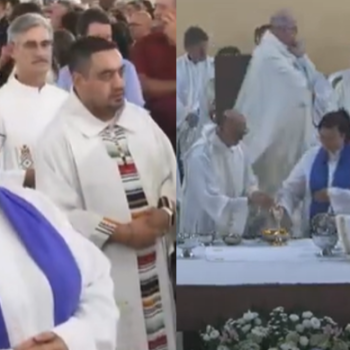
The holes in my socks were hard to ignore. But I had to take my shoes off anyway.
As I approached the metal detectors at the entrance to the Bait ul-Futuh Mosque in South London — the United Kingdom’s largest — I removed my footwear, as is customary in any masjid, and prepared to explain my embarrassment.
You see, I was in London for a rugby match and was wearing my fifteen-year-old “lucky socks” for my favorite team. With the match taking place that Friday evening, I wore them for my visit for jummah (gathering) prayers in the afternoon.
I was there to visit the mosque, rebuilt after a fire in 2015, to stand in awe of its architecture, and get a glimpse into the lived religious rhythms of the UK’s some 30,000 Ahmadis.
Usually, I don more respectable socks when I visit a mosque (and in life generally). But this time, with my pinky toe poking out on my right foot, I removed my shoes and walked toward my hosts, Athar and Sabah, making excuses for why my feet were so woefully adorned.
They both laughed it off, bantering a bit about my rugby obsession, more interested in whether or not I believed my lucky socks helped the team (apparently not, as they lost 35-7 that night) than offended by holey footwear.
The experience not only provided some laughs and fond memories but helped emphasize once again the value of experiential learning and interactive site visits in service of religious literacy.
The classroom comes alive.
I’ve been leading and going on religious site visits for more than two decades. Beyond going to the local synagogues, wards, temples, or churches of friends I grew up with in the greater Los Angeles area, one of my first memories of an experiential learning encounter was at the Fo Guang Shan Hsi Lai Temple mountain monastery in the hills of Hacienda Heights, California.
I went with a group of university students enrolled in a “world religions” survey course. Taking in the golden representations of Buddha’s disciples in the Arhat Garden and sitting for a moment’s reflection in the Boddhisattva Hall before taking in a brief introduction to Buddhist traditions in one of the lecture rooms, I realized that what I’d learned in the insulated conditions of the classroom came alive and became concrete in the context of lived experience.
Since then, I’ve always sought to include an experiential element in my own “intro to religion” courses. Whether in New Zealand, Arizona, Texas, Florida, or Canada, I’ve taken students on tours and trips to local mosques and monasteries, shrines and synagogues.
When I was in Houston, Texas these experiences proved ridiculously easy to coordinate. In the Bayou City’s southeast, in the space of just one block along Synott Rd., there stand three Hindu temples, a masjid, a Buddhist monastery, a Syrian Orthodox Church, and a smattering of evangelical and Pentecostal congregations. Over four years, I took students and local politicians, non-profit leaders and members of the Church of Jesus Christ of Latter-day Saints on “Houston World Tours,” where people learned firsthand, processing what they’d seen, heard, smelled, tasted, and touched as we engaged in intentional reflection afterward.
One time, over pupusas just around the corner from a Chinese Baptist Church nearby, that a group told me that being offered prasadam (sharing of food) for the first time, being asked if they wanted to light incense on behalf of their ancestors, and learning about how Jesus is a prophet from the Islamic perspective opened their eyes to the wide world of religion and shone a light on all the things they did not know, they did not know.
Here and now.
Indeed, it is hard to overstate the value of interactive site visits and experiential education when it comes to religion. Not only do such encounters highlight the variety of religious experience and the multitude of embodied religious practices, ritual, and community, but they help students focus on the immediate and the present.
Most classrooms are oriented toward the past or the future, according to the Boston University Center for Teaching and Learning. Historical context and future-oriented learning are beneficial, no doubt. But “experiential learning allows students to engage in the here and now,” reinforcing the value of learning about religious traditions today, because it is tied to tangible objects and live action in the present.
Experiential learning also places students in real world situations that often require them to engage with contexts, people, and problems they are typically not presented with. I remember one conservative Christian adult education group that was quite confused over whether or not they could partake of food offered to them at a Sikh gurdwara. Though initially reticent to receive the gift, they decided to enjoy the gulab jamun and sohan halwa as they sat and listened to a brief lecture on the centrality of the Guru Granth Sahib (the Sikh scripture) and the value of truthful living.
Such experiences foster social and interpersonal growth as people recognize their biases and blindspots, learn from their mistakes and missteps, and understand that they cannot control the outcome of engagement and dialogue.
How to make it happen.
There are hundreds of enriching opportunities in any city that can give students realistic and challenging experiences. Even smaller towns and regions have more religious diversity than you might at first imagine. Though I offer examples from tours of religious establishments, students can also attend religious services in progress (with proper permissions, of course) or benefit from organized events that bring representatives of various religious communities to your learning community (when and where appropriate and permissible).
Each brings its own set of ethical considerations and challenges of course. Learning leaders and facilitators should be aware of the power dynamics of inviting oneself, or group, into another’s sacred space. Likewise, proselytization, debates, and confrontations can provoke, rather than promote, learning. The key is to prepare students with a posture of respect and critical curiosity, using times of intentional, guided reflection afterward to unpack any awkwardness, anger, or affront.
In the end, it is far too easy to dismiss others’ religious perspectives from a distance. A critical intimacy and experiential encounter open us to a richer understanding of how religious actors see and fashion themselves, granting us an opportunity to see religion expressed in all its varied complexity.
Humbled by the process.
If you’re a teacher or learning leader, rather than having students take a test or submit a paper at the end of the semester, consider assigning interactive and experiential exercises that challenge them to apply their understanding of “religion” as a category of critical consideration in concrete, flesh-and-blood social situations.
Even if you’re not a teacher, consider how you might fold an element of religious tourism into your next itinerary. Here’s a handy list of a hundred sacred sites around the world to kindle your imagination. Not able to travel right now? Take a virtual tour of major religious sites around the world.
The point is this: Experiential learning engages the body’s senses, creating concrete opportunities for critical reflection on this thing we call “religion.”
So, whether you are a student or teacher, reporter or religious leader (or have holes in your socks or not!), consider a religious site visit in the near future. You’ll not only learn something but might walk away humbled by the process.
Resources and further reading.
•Carleton University “An Interactive and Experiential Approach to Teaching Religion.”
•Interfaith America, “Guide for Religious Site Visits.”
•How To Be a Perfect Stranger: The Essential Religious Etiquette Handbook
11/9/2023 4:46:15 AM



-350x350.jpg)

